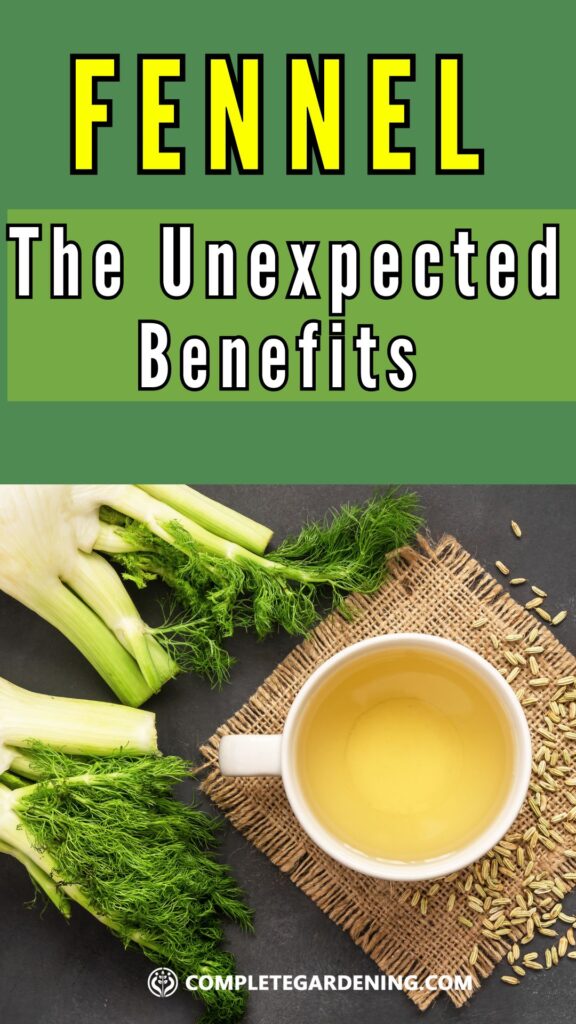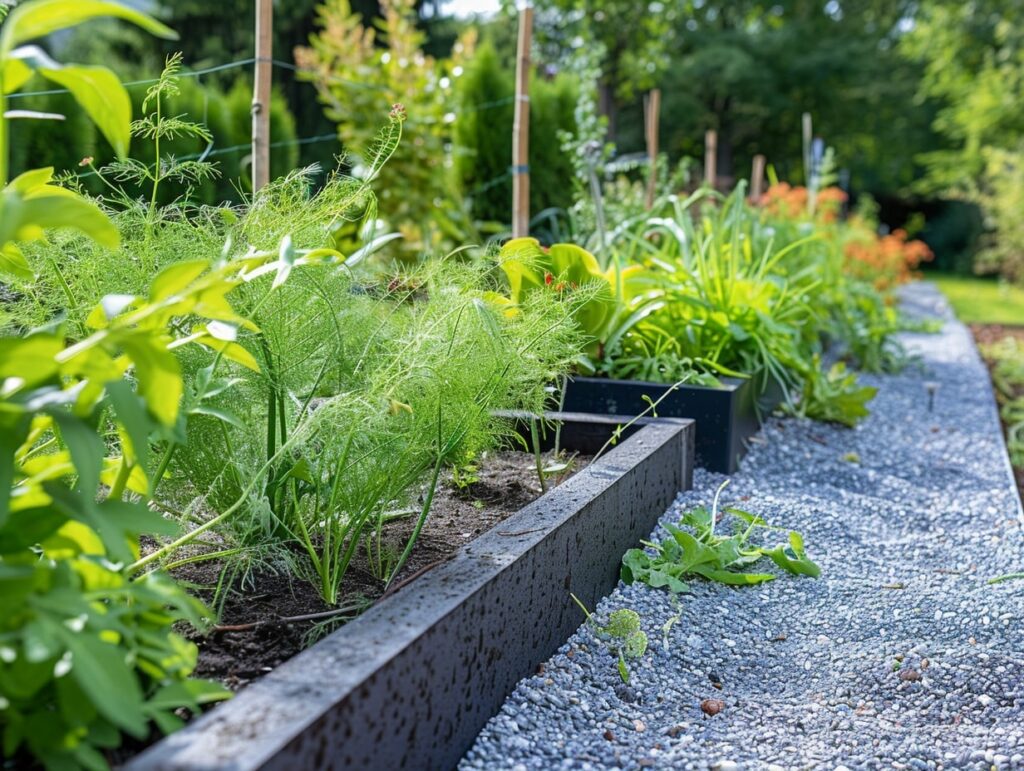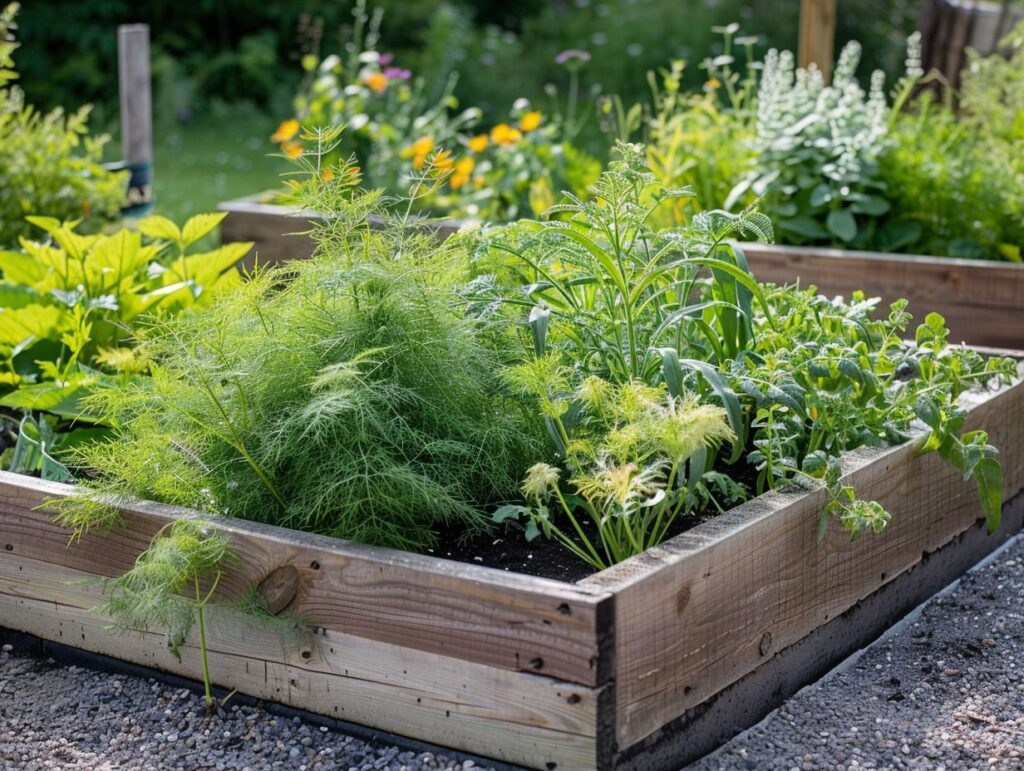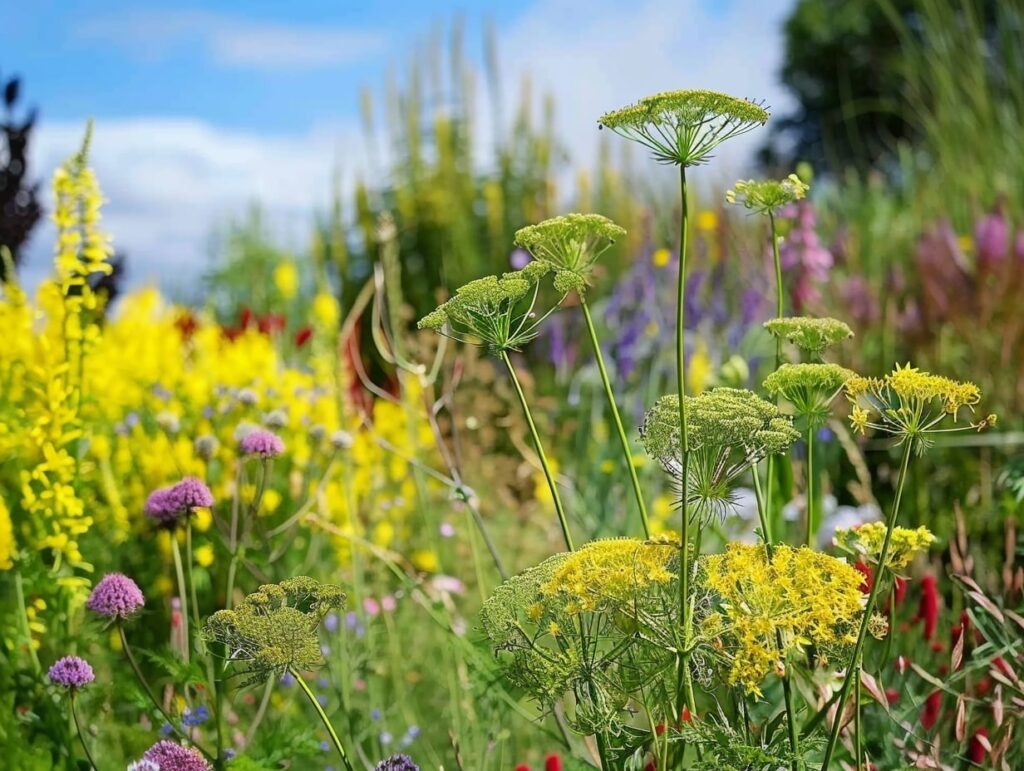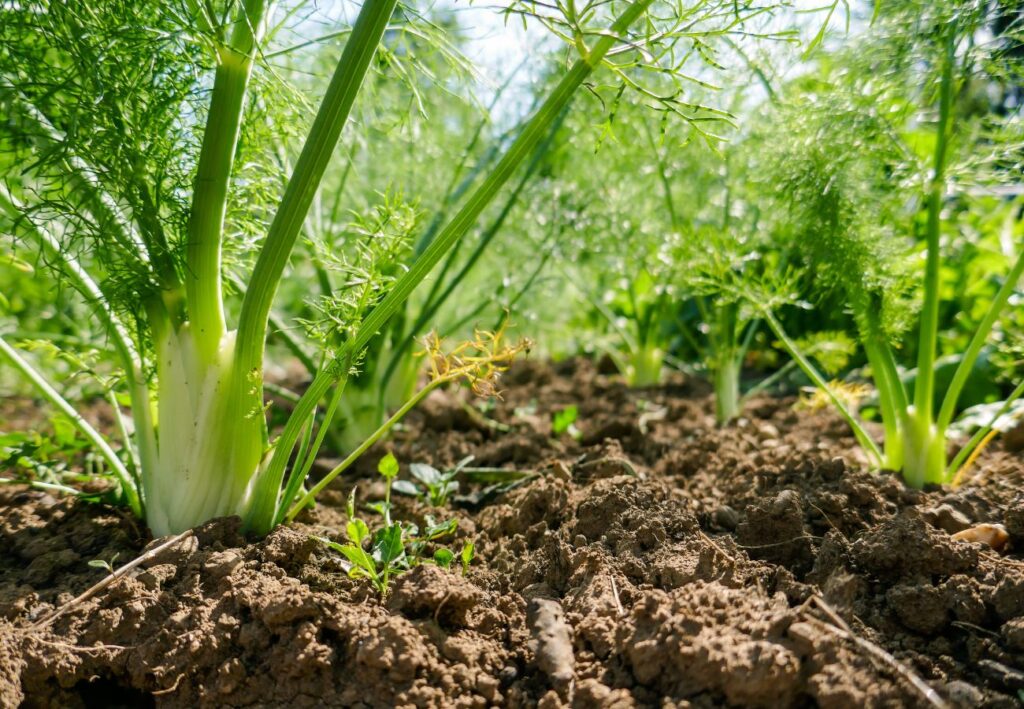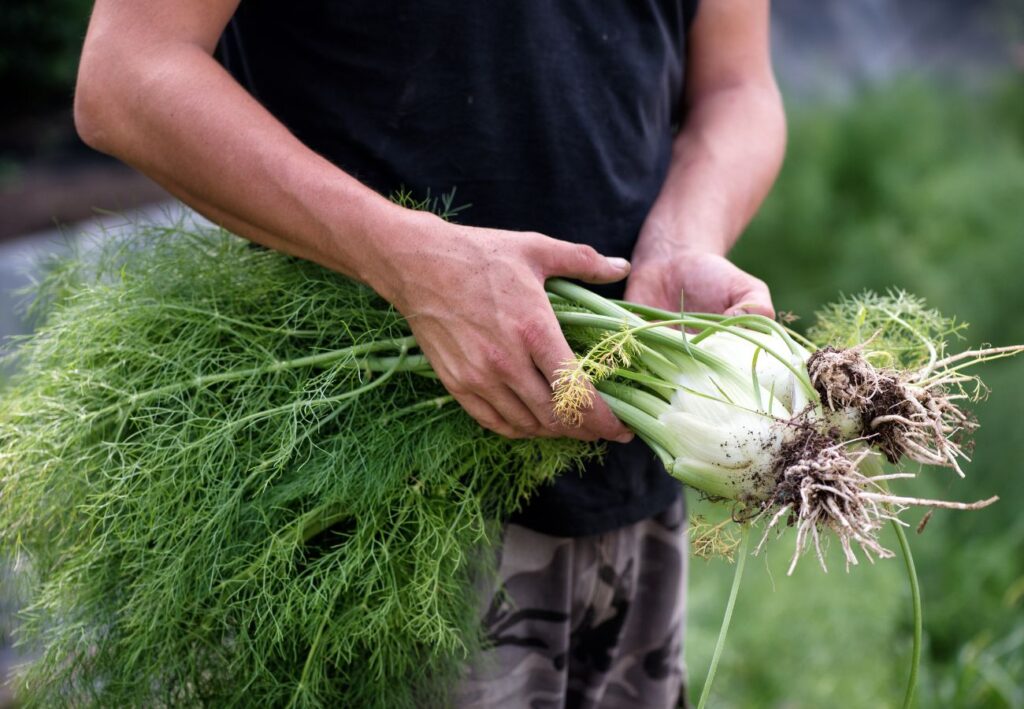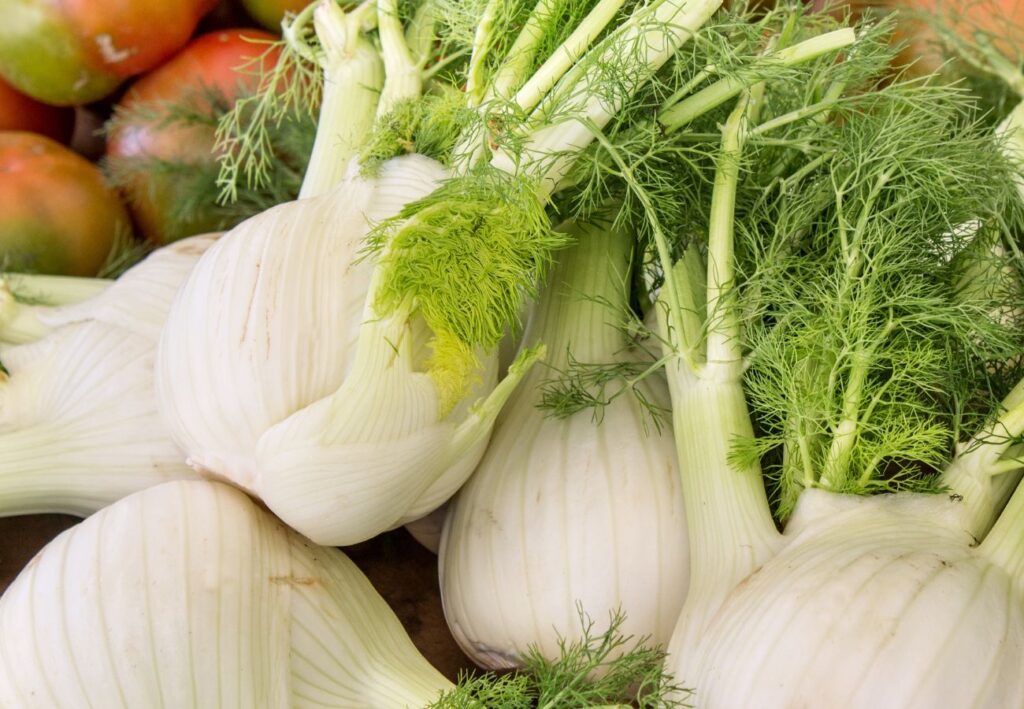Fennel might seem like an exotic addition to your garden, but it comes with its own set of challenges. It can inhibit the growth of other plants due to its allelopathic properties.
This means it releases chemicals that can stunt the growth of your other garden favorites.
Despite its disruptive nature, fennel offers unique benefits that can make it worth the trouble. Fennel attracts beneficial insects like ladybugs and parasitic wasps, which can help control garden pests.
Plus, its culinary versatility and sweet, anise-like flavor can elevate your cooking. You’ll find fennel is a delightful herb both for its fragrant foliage and its place in your kitchen.
Fennel Fundamentals
Before adding fennel to your garden, it’s crucial to grasp both its characteristics and potential impacts.
Understanding Fennel
Fennel (Foeniculum vulgare) is a perennial herb belonging to the carrot family. It has feathery leaves and yellow flowers and can grow up to six feet tall.
Native to the Mediterranean, fennel thrives in well-drained soil and full sun. It is known for its distinct anise-like flavor, making it popular in cooking.
Despite its culinary appeal, fennel can be invasive. It produces large quantities of seeds that spread easily, potentially crowding out other plants. This makes management a key consideration when introducing fennel into your garden.
The Unique Traits of Fennel
Fennel’s entire plant is edible. The bulb, stalks, and fronds can be used in various dishes. The seeds serve as a spice, commonly found in sausages and bread. Its essential oils are also used in aromatherapy and herbal remedies.
In the garden, fennel can attract beneficial insects like ladybugs and predatory wasps, aiding pest control. Additionally, it has deep roots that can help aerate the soil.
Despite its benefits, fennel’s allelopathic properties can inhibit the growth of some nearby plants, making careful placement essential.
Gardening Challenges with Fennel
Growing fennel in your garden comes with certain challenges. Its aggressive growth and potential for cross-pollination can complicate your gardening efforts if not managed properly.
Fennel’s Aggressive Growth
Fennel grows rapidly and can quickly occupy a significant portion of your garden space. This vigorous growth can crowd out nearby plants, competing for sunlight, water, and nutrients. You might find it difficult to control fennel as it spreads out.
Fennel releases chemicals that inhibit the growth of nearby plants. This phenomenon, known as allelopathy, can stifle the growth of your vegetables and flowers. Be prepared to invest more time in monitoring and managing your garden to keep fennel in check.
Using barriers or designated planting areas can help contain its spread. Keeping fennel in containers is another practical solution to prevent it from overtaking your garden.
Risk of Fennel Cross-Pollination
Fennel can easily cross-pollinate with other plants in its family, such as dill. This can result in hybrid plants that may not have the desirable traits of either parent. If you are growing fennel for its specific characteristics, this cross-pollination can be problematic.
To reduce the risk, you can plant fennel far from other umbellifers like dill and coriander. A distance of at least 200 feet is recommended to minimize the chances of cross-pollination.
You can also use physical barriers, such as mesh coverings or plant fennel at different times than other related species. This ensures that they do not flower simultaneously, further reducing the risk of cross-pollination.
Ecological Considerations
Fennel can attract beneficial insects and serve as an effective “trap crop” for pests. These ecological roles can improve overall garden health and create a balanced environment.
Attracting Beneficial Insects
Fennel produces umbrella-shaped flower clusters that are a magnet for beneficial insects. Ladybugs, hoverflies, and parasitic wasps are all drawn to fennel’s nectar.
These insects help control garden pests like aphids and caterpillars.
You might notice more of these helpful bugs if you plant fennel near your other crops. This can reduce your need for chemical pesticides and promote a healthier garden ecosystem.
Fennel provides shelter and food, making it an ideal plant for ecological pest management.
Fennel’s Potential as a ‘Trap Crop’
Fennel can act as a “trap crop,” luring pests away from more vulnerable plants. For example, aphids and certain types of caterpillars prefer fennel, leaving your tomatoes and lettuces alone.
By planting fennel around the edges of your garden, you create a buffer zone.
This approach can minimize pest damage to your primary crops. It’s a simple, organic way to manage pests without resorting to harsh chemicals. Just be sure to monitor the fennel itself and remove any pests before they have a chance to spread.
Cultivation Tips for Fennel
Growing fennel in your garden is rewarding if you follow certain planting and care guidelines. It’s crucial to know where, how, and when to plant fennel and how to maintain it for optimal growth.
Best Practices for Planting
Choose the Right Location: Fennel thrives in full sun. Select a spot that gets at least six hours of sunlight each day. This will ensure vibrant growth and a healthy plant.
Soil Requirements: Ensure the soil is well-drained and rich in organic matter. A pH level of 6.0-7.0 is ideal. You may need to add compost or a balanced fertilizer to provide the necessary nutrients.
Planting Time: Plant fennel in early spring after the last frost. Direct sow the seeds about 1/4 inch deep. Space them 12-18 inches apart to give each plant enough room to grow.
Watering: Keep the soil consistently moist during the germination period. Water lightly, but do not let the soil become waterlogged.
Maintenance and Care
Regular Watering: Once established, fennel needs regular watering to maintain soil moisture. Water deeply but infrequently. Aim for about an inch of water per week. Monitor soil moisture to avoid over or under-watering.
Fertilization: Feed fennel with a balanced fertilizer every few weeks during the growing season. Organic options such as compost tea can also be beneficial.
Weeding: Keep the area around fennel plants weed-free. Mulching can help suppress weeds and retain soil moisture.
Pest Control: Watch out for pests like aphids and caterpillars. Use organic pest control methods, such as neem oil or insecticidal soap, to manage any infestations.
Harvesting: Harvest fennel bulbs when they are about the size of a tennis ball. Cut the bulb at the soil level, and you can also enjoy the fronds and seeds for culinary uses.
Harvest and Usage
Harvesting fennel involves both its bulbs and seeds, which offer varying culinary and medicinal benefits. Each part of the plant has specific uses and harvesting techniques that can enhance your gardening and cooking experience.
Harvesting Fennel Bulbs and Seeds
For fennel bulbs, start harvesting when they reach about the size of a tennis ball. Use a sharp knife to cut the bulb just above the soil line. Ensure the cut is clean to avoid any damage to the plant.
Seeds can be collected after the plant flowers and the seeds turn brown. Cut the seed heads and place them in a paper bag. Store them in a dry, cool place until they are fully dry, then shake the bag to release the seeds.
Culinary and Medicinal Uses
Fennel bulbs are popularly used in cooking for their sweet, anise-like flavor. They can be grilled, sautéed, or eaten raw in salads. Seeds are often used as a spice and provide a distinct flavor to bread, sausages, and curry dishes.
Medicinally, fennel seeds are known for aiding digestion and relieving bloating. You can make a tea by steeping the seeds in hot water for a soothing digestive drink.
Both bulbs and seeds are versatile ingredients that can be incorporated into your diet for various health benefits.
Incorporating fennel into your garden can be both a rewarding and challenging endeavor. While its allelopathic properties and vigorous growth can pose significant challenges, the benefits of attracting beneficial insects and its versatile culinary uses make it an intriguing addition to any garden.
By carefully managing its placement and growth, you can enjoy the unique advantages fennel offers without compromising the health of your other plants.
Whether you’re looking to enhance your garden’s ecosystem or elevate your cooking with its distinct flavor, fennel proves to be a valuable and multifaceted herb worth considering.

